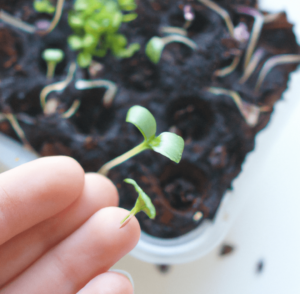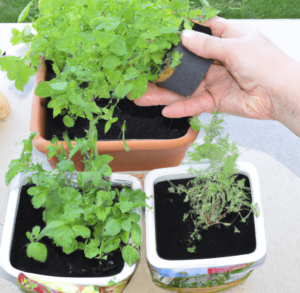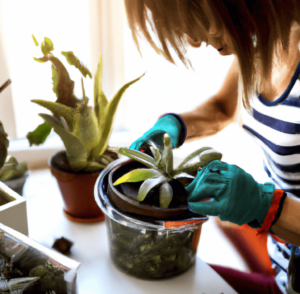Native plants are those that are geographically specific and that have developed to grow in that area’s soil, climate, and other environmental factors. Compared to non-native plants, these plants require less gardening maintenance and are more resistant to pests and diseases since they are well adapted to their habitat. If you’re itching to learn about how to grow native plants, keep reading!
Choosing the Right Native Plants
It’s crucial to take the local ecosystem into account when selecting plants for your garden or landscape after you learn how to grow native plants. Participating in a local plant education program is one approach to be sure you are choosing the proper plants. These programs might offer details on the particular native plant varieties that flourish in your region as well as their function in fostering biodiversity.

In general, you can choose the right native plants from gardening guides or experts:
- Root System: It’s crucial to take the plant’s root system’s size and distribution into account. Some plants might compete with nearby plants for nutrients and water because of their large root systems.
- Biodiversity: Pick plants that help the neighborhood environment by giving local insects, birds, and other species food and habitat.
Consider the quantity and type of sunlight, moisture, and soil while choosing your planting location. Make sure to pick plants that are appropriate for the local climate.
Types of Native Plants
You have to think about how to grow native plants well in your specific area. Your gardening objectives and your garden’s growing conditions, such as the amount of sunlight, the kind of soil, and the level of moisture, will determine the native plants you select.
Common native plant species include trees, shrubs, perennials, and ground coverings:
- As their name suggests, ground covers cover the ground and stop soil erosion.
- In addition to giving the garden structure, shrubs provide a habitat for wildlife.
- Trees give height and shade, whereas perennials are plants that grow year after year.
Selecting Plants Based on Climate, Soil, and Light Conditions
When you’re learning how to grow native plants, it’s crucial to pick plants that will thrive in the location’s particular soil, climate, and lighting circumstances. This will make sure your plants survive and produce the outcomes you want:
- Pick plants that will thrive in your region’s specific ranges of temperature, amount of precipitation, and humidity. While some plants are hardier than others, some are sensitive to harsh weather.
- Think about the kind of soil you have in your garden or planting area. While some plants prefer moist or marshy environments, others need soil that drains properly.
- Establish the amount of sunlight and shadow that your garden or planting space receives. While some plants enjoy the partial or complete shade, others need full light.
Your garden or planting area will thrive if you choose species that are adapted to the soil, climate, and lighting in your location.
When to Plant Native Plants
When you’re learning how to grow heirloom plants or native ones, timing matters. Depending on the species and your environment, there is a particular time of year when most native plants are best suited for planting.
Native trees, shrubs, and perennials should generally be planted in the fall or spring when the soil is moist and the weather is cooler. By doing this, the plants can establish their roots before the summer’s heat hits.
Some native plants can be planted in the summer as well, but frequent watering is necessary for them to establish themselves.
Preparing the Soil
When you’re learning how to grow native plants, preparing the soil means determining the type of soil in your area. You can better comprehend its structure, fertility, and pH level thanks to this.
- Boost the soil’s structure: In order to strengthen the soil’s structure and promote root development, add organic materials, such as compost or peat moss.
- To find out if the soil is too acidic or alkaline for the plants you intend to cultivate, test the pH of the soil. You can learn the ideal pH for your plants via a local plant education program.
- To repair nutritional deficiencies and encourage healthy plant growth, you may need to add fertilizer or other soil amendments.
Understanding Soil Types and pH Levels
Learning how to grow native plants means understanding the different types of soil. The nutrients that are available to the plants depend on the soil type and pH level, which may have an effect on their growth and health.
The majority of native plants demand soil that drains well and has a pH between 6.0 and 7.0, which is somewhat acidic. You can get a soil test kit from a garden center or hire a professional soil tester to determine the type of soil and pH level in your garden.
You might need to supplement the soil with compost, mulch, or other organic materials based on the findings of the soil test in order to increase its structure and fertility. By doing this, you can make sure that your local plants get the nutrients they require to develop and thrive.
Amending Soil for Native Plants
By including native plants in your garden or planting area, you may support biodiversity. Native plants are an essential component of the regional environment. It’s critical to modify the soil to fulfill the unique requirements of these plants in order to assure their success. You can learn how to grow native plants and amend the soil with the following tips:
- Compost, leaves, or other organic matter can be added to the soil to strengthen its fertility and structure.
- Native plants frequently have particular pH requirements, so it may be required to do so. You can learn the ideal pH for your plants via a local plant education program.
- It’s crucial to reduce soil disturbance when planting native species to protect vulnerable root systems. To reduce soil disturbance, take into account adopting strategies like direct seeding or planting seedlings.
Planting
Knowing how to grow native plants is planting them well:
- Pick the correct spot: When deciding where to plant your native plants, take into account the quantity of sunlight, the type of soil, and the humidity levels.
- Prepare the soil properly: Make sure the soil is well-drained, and add compost, mulch, or other organic materials as necessary to improve it.
- Select the proper plant size: When selecting a size for planting, take the plant’s mature size into account. Larger plants will take longer to establish, but smaller plants are frequently less expensive.
- Planting at the proper depth Make sure the plant’s crown is at or just above soil level and that the roots are completely encased in soil.
- After planting, make sure to give your native plants plenty of water to help them take root.
Proper Spacing
Whether you’re learning how to grow bulb flowers or native plants, proper spacing is important:
- Plant size: The mature size of the plants you are utilizing should be taken into account when planting. Make sure there is adequate room between each plant to support its growth.
- Root development: Sufficient root development is essential for the overall health of the plants and is made possible by appropriate spacing.
- Air movement: Enough distance between plants encourages excellent air movement, which can lower the danger of fungi illnesses.
- Enhance biodiversity: By enabling a variety of plant species to flourish, proper spacing helps to promote biodiversity in your garden or planting area.
Depth for Planting
The type of plant, the type of soil, and the growing circumstances in your area all affect how deeply you should plant your native plants. The majority of native plants should typically be planted with their crowns at or just above the soil line.
The plant’s stem and roots converge at a place known as the crown. While planting the crown too shallowly can expose the roots and cause dryness, planting the crown too deeply can result in root rot and other issues. It is crucial to check that the root flare, which is the largest part of the trunk, is visible above the ground while planting trees. As a result, the roots can grow and can avoid issues like girdling roots.
Watering and Care Instructions
Now that you know how to grow native plants, you can water and take care of them if you:
- Know Your Plants: Different species have different water requirements. Make sure to research the specific needs of each plant you are planting.
- Monitor Soil Moisture: Regularly check the soil moisture level to ensure that your plants are receiving enough water.
- Watering Schedule: Develop a watering schedule that takes into account the specific needs of each plant and the climate in your area.
- Mulching: Consider adding a layer of mulch around the base of your plants to help conserve moisture and regulate soil temperature.
- Careful Weeding: Regularly removing weeds from your garden or planting area can help to reduce competition for water and nutrients.
By following these tips and engaging in regular garden maintenance and care, you can help ensure the success of your plants and promote biodiversity in your garden or planting area.

Caring for Native Plants
The final step in learning how to grow native plants is caring for them:
- Watering: Native plants typically require regular watering, especially during dry periods. Be sure to water your plants deeply to encourage deep root growth.
- Mulching: Adding a layer of mulch around your plants can help retain moisture and suppress weeds.
- Pruning or deadheading: Pruning is an important aspect of caring for native plants. Regular pruning helps maintain the shape and size of the plant, encourages new growth, and can improve the overall health of the plant.
- Fertilizing: Most native plants do not require fertilizer, but if your soil is poor, you may need to add fertilizer to improve the soil quality.
- Pest control: Native plants are often more resistant to pests and diseases than non-native plants. However, if you notice any signs of a pest or disease, it’s important to address the problem promptly to prevent it from spreading.
- Winterizing: You may use techniques like covering plants with mulch, providing insulation for roots, and choosing plants that are well-suited for the local climate to winterize your native plants.
Specific Care for Different Types of Native Plants
Native plants play a crucial role in maintaining biodiversity and preserving the natural ecosystem. Now that you know how to grow native plants, there are specific guidelines you need to keep in mind:
- Consider the location: Different types of native plants have varying requirements for sunlight, water, and soil. Before planting, it’s important to research the specific needs of each plant and select a location that meets those requirements.
- Planting: When planting, be mindful of the plant’s root system. Some native plants have delicate roots that should be handled carefully, while others have more robust roots that can handle rough handling. Additionally, it’s important to follow proper planting techniques, such as digging a hole that is the same depth as the root ball and not planting the plant too deeply.
- Watering: Adequate watering is crucial for the survival of native plants. Some native plants require frequent watering, while others are more drought-tolerant and only need to be watered occasionally. It’s important to research the specific watering requirements for each type of plant and follow them closely.
- Education program: Consider enrolling in a plant education program to learn more about the specific care requirements for different types of native plants. These programs can provide hands-on learning experiences and provide a wealth of information on how to successfully plant and maintain native plants.
Maintenance
Plants, like all living things, require regular care to thrive. Proper maintenance is key to keeping your garden healthy and beautiful. Here are some basic tips to help you maintain your gardening area.
- Consider using native plants. Native plants are well adapted to the local climate and soil conditions, making them easier to care for and less likely to attract pests and diseases.
- Keep the ground covered. A layer of mulch or ground cover helps to conserve moisture and regulate soil temperature, which is important for healthy plant growth.
- Regularly remove dead or yellowing leaves, stems, and flowers. This will help to prevent the spread of disease and keep your garden looking tidy.
- Water your plants as needed, taking into account factors like the weather and the type of plants you have. Over-watering can be just as harmful as under-watering, so be mindful of the amount of moisture your plants receive.
- Regularly check for pests and diseases and take action promptly if you notice any issues. This can help to prevent small problems from becoming big ones, and ensure that your plants stay healthy and vigorous.
Bottom Line: How to Grow Native Plants
If you’ve been looking for a sign to learn how to grow native plants, this is it. Not only is seeing the progress from seed to wildflower, tree, or shrub amazing, but you can put your landscaping skills to the test while contributing to the biodiversity in the area.
FAQs on How to Grow Native Plants
What are indigenous plants?
Native plants are those that have evolved to flourish in a particular region’s soil, climate, and other natural conditions.
What benefits come with cultivating native plants?
Native plants promote biodiversity preservation by requiring less maintenance and being more resistant to pests and illnesses.
How can I select the best native plants?
When choosing plants, consider the local environment. Consider the root system, biodiversity, sunlight, moisture, soil, and local climate while selecting plants, take part in a local plant education program, and more.
What common varieties of local flora are there?
The most prevalent native plant species include trees, shrubs, perennials, and ground covers.
How should I choose plants based on the soil, climate, and light conditions?
Pick plants that will flourish in the particular soil, climate, and lighting conditions of the area. Take into account the temperature, precipitation, humidity, kind of soil, amount of sunlight, and shadows.
What time of year is ideal for native plant planting?
Depending on the species and the environment, the optimum time to plant varies, but native trees, shrubs, and perennials should typically be planted in the fall or spring.
What role does preparing the soil for planting play?
To ensure the success of your plants, proper soil preparation is essential. Establish the type of soil, enhance the soil’s structure, check the pH, and, if necessary, add fertilizer or other soil amendments.
What depth should native plants be planted at?
Depending on the type of plant, the type of soil, and the local growing conditions, the ideal depth for planting native plants varies. The crowns of the majority of native plants should be placed at or slightly above the soil line when planting.
What advice is there for maintaining native plants?
In order to maintain native flora, it’s crucial to water your plants, use mulch, prune, fertilize, and use pest control methods.
What is some watering advice for plants?
Understand your plants, track the soil’s moisture, have a schedule, and don’t overwater your plants.
What use does fertilizing native plants serve?
Fertilizing can assist enhance the condition of the soil and encourage the growth of native plants. Although most native plants don’t need fertilizer, doing so can still be beneficial.







